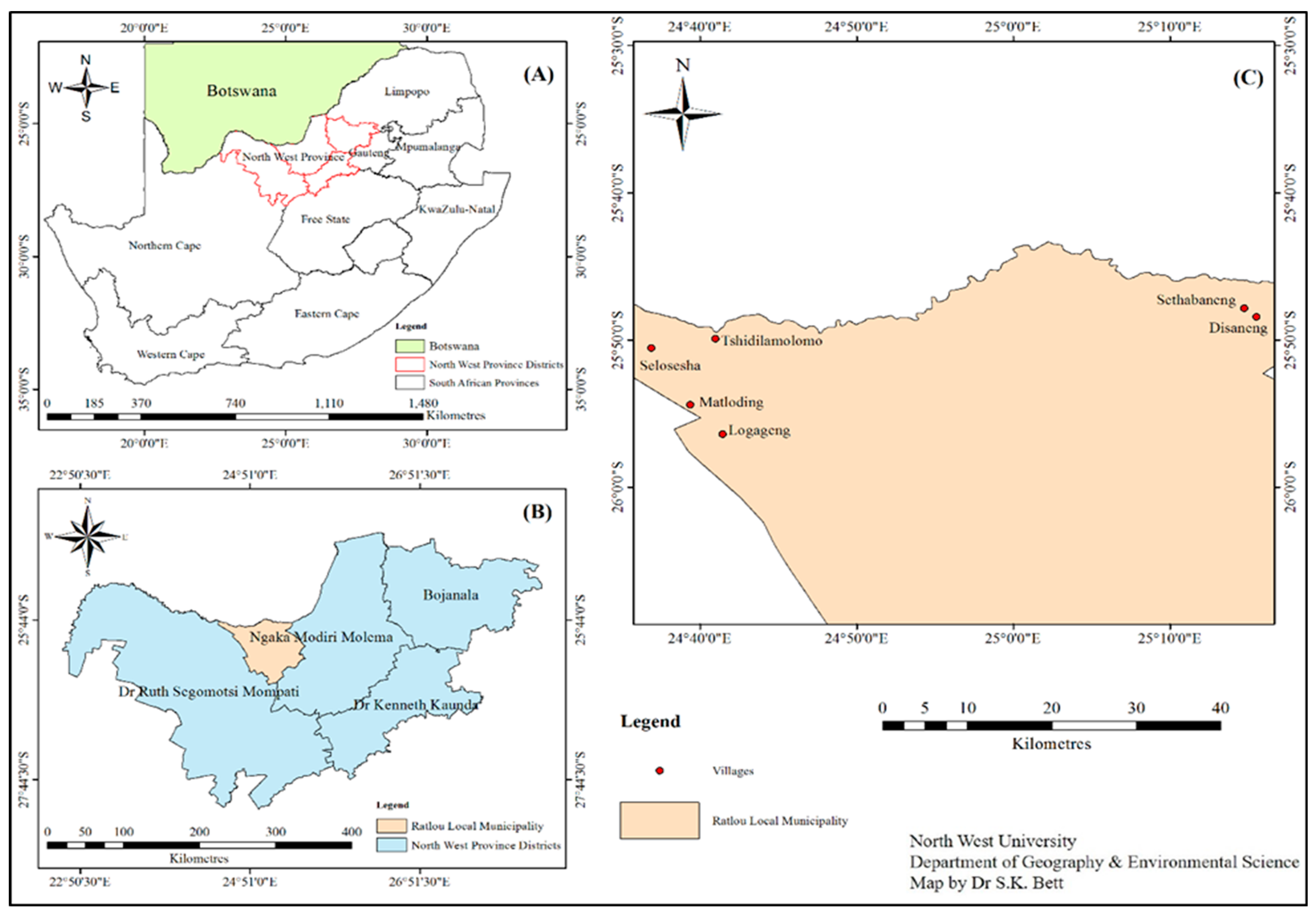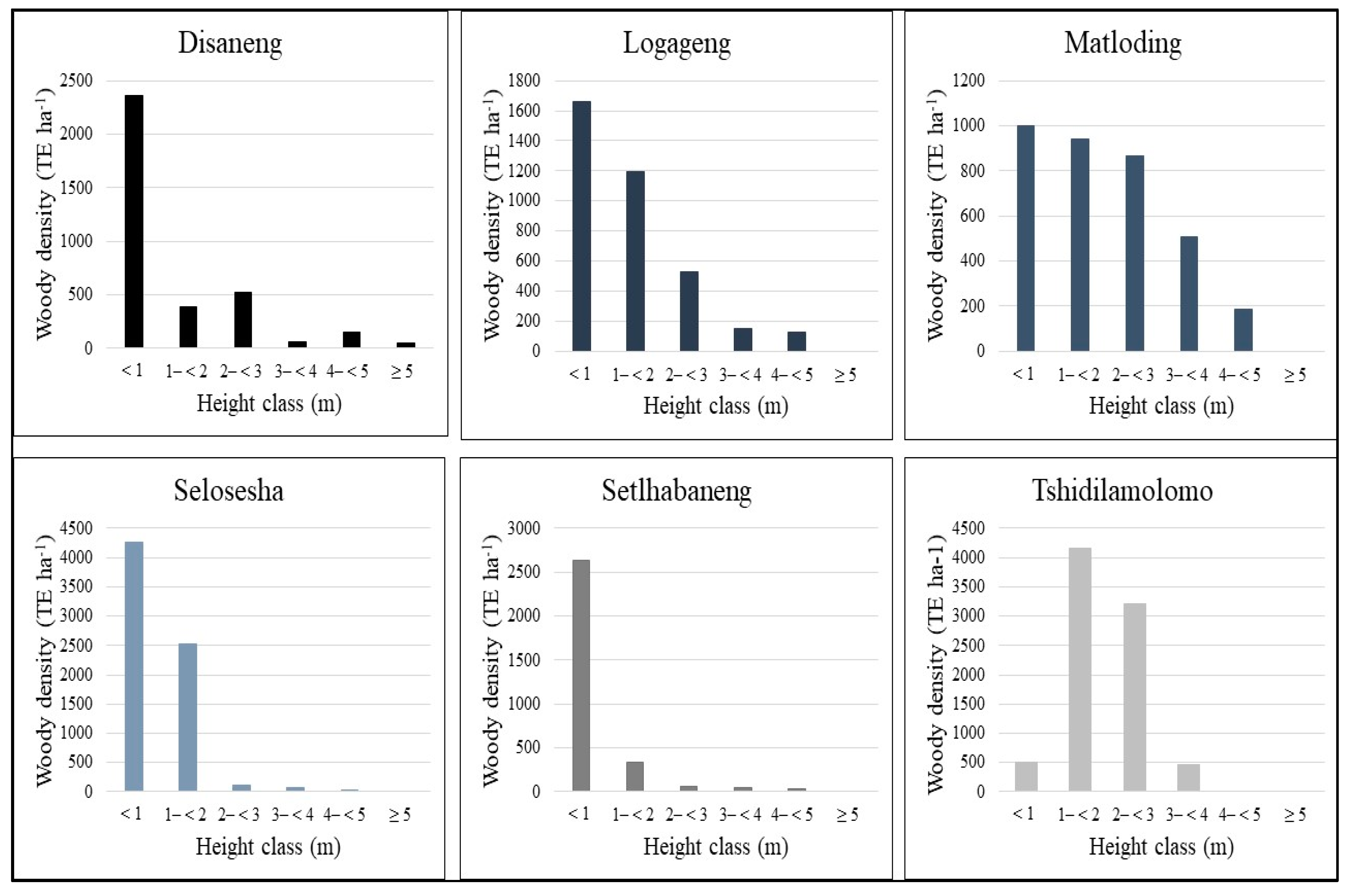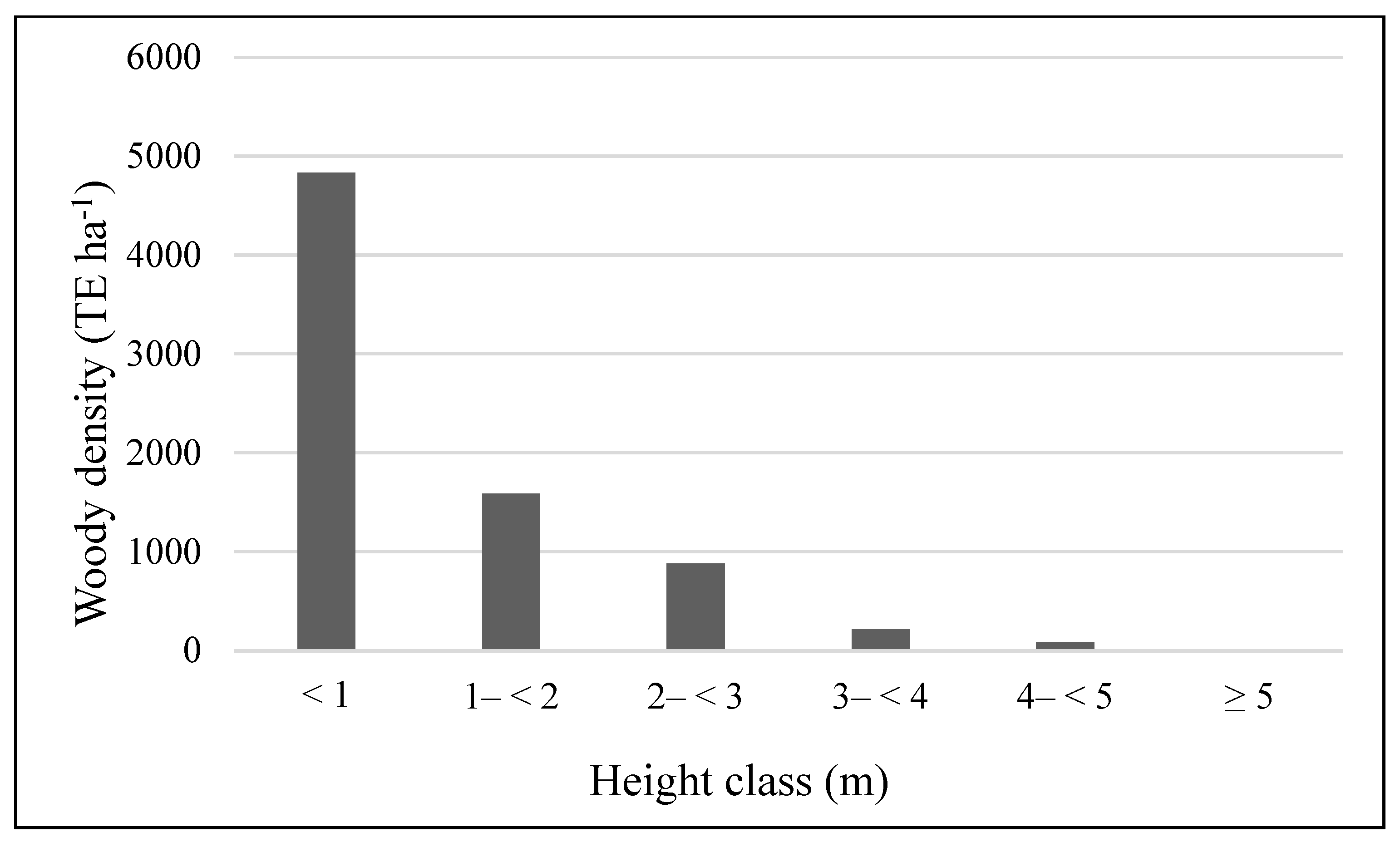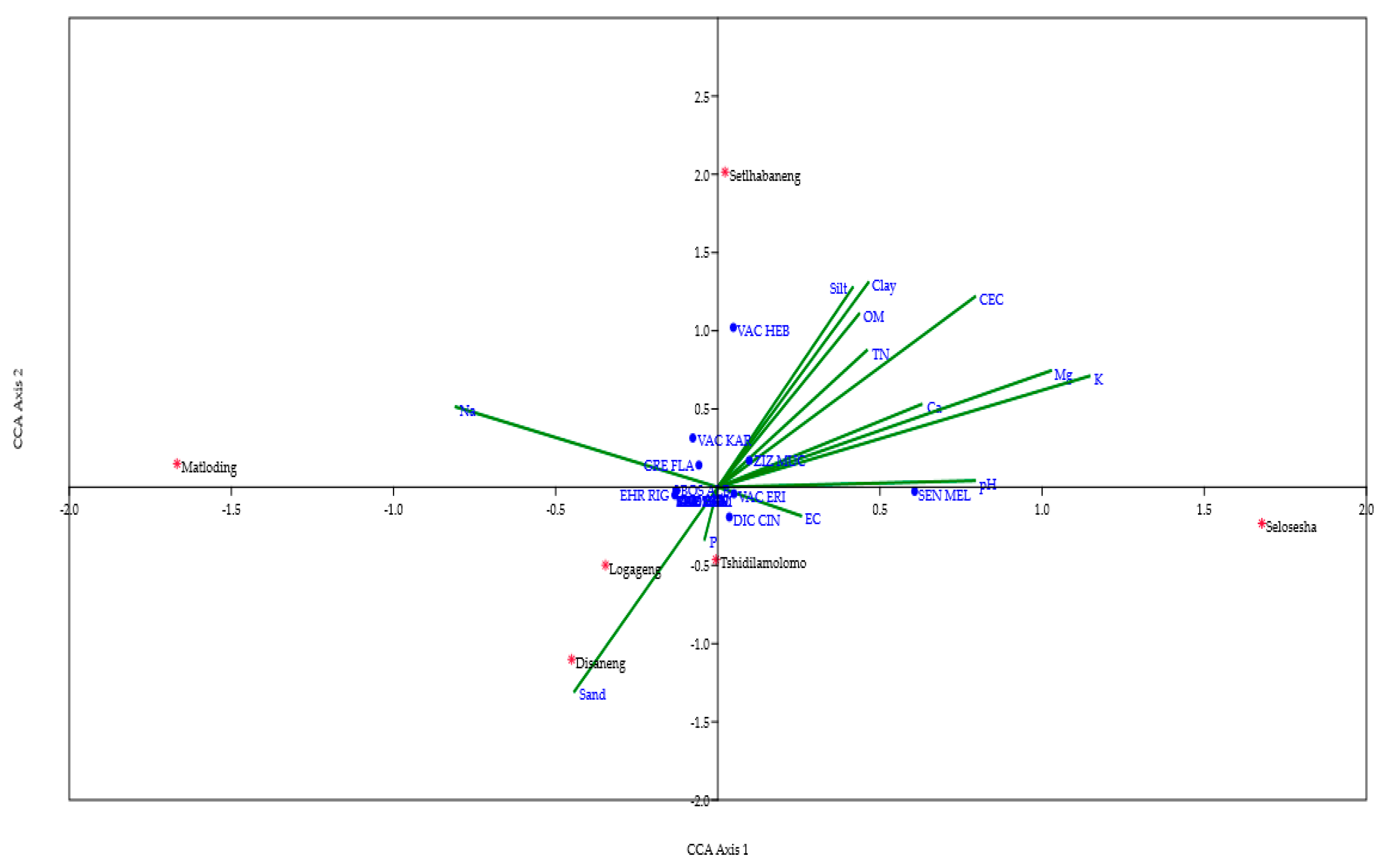Effects of Soil Properties on the Distribution of Woody Plants in Communally Managed Rangelands in Ngaka Modiri Molema District, North-West Province, South Africa
Abstract
1. Introduction
2. Materials and Methods
2.1. Study Area
2.2. Experimental Design
2.2.1. Vegetation Sampling
2.2.2. Soil Sampling
2.3. Data Analysis
3. Results
3.1. Woody Species Composition and Abundance
3.2. Vegetation Structure
3.2.1. Density and Frequency of Woody Plant Species among the Study Sites (n = 30)
3.2.2. The Combined Density of all Woody Plant Species of Different Height Class Distribution at Various Sites (n = 30)
3.3. Variation in Soil Properties between the Six Selected Communally Managed Rangelands
3.4. Effect of Soil Properties on Tree Species Distribution
4. Discussion
4.1. Woody Species Composition and Abundance
4.2. Vegetation Structure
4.2.1. The Density and Frequency of Woody Plant Species among the Study Sites
4.2.2. Woody Plant Height Class Distribution
4.3. Variation in Soil Properties between the Six Selected Communally Managed Rangelands
4.4. Effect of Soil Properties on Tree Species Distribution
5. Conclusions
Author Contributions
Funding
Institutional Review Board Statement
Informed Consent Statement
Data Availability Statement
Acknowledgments
Conflicts of Interest
References
- Drake, J.A.; Mooney, H.A.; di Castri, F.; Groves, R.H.; Kruger, F.J.; Rejmanek, M.; Williamson, M.D. (Eds.) Biological Invasions: A Global Perspective; John Wiley: Chichester, UK, 1989. [Google Scholar]
- Reynolds, J.F.; Stafford Smith, D.M. Global Desertification: Do Humans Cause Deserts? Dahlem Workshop Report 88; Dahlem University Press: Berlin, Germany, 2002; p. 437. [Google Scholar]
- Van Auken, O.W. Shrub invasions of North American semi-arid grasslands. Annu. Rev. Ecol. Evol. Syst. 2000, 31, 197–215. [Google Scholar] [CrossRef]
- Eldridge, D.J.; Bowker, M.A.; Maestre, F.T.; Roger, E.; Reynolds, J.F.; Whitford, W.G. Impacts of shrub encroachment on ecosystem structure and functioning: Towards a global synthesis. Ecol. Lett. 2011, 14, 709–722. [Google Scholar] [CrossRef] [PubMed]
- Anadón, J.D.; Sala, O.E.; Turner, B.L.; Bennett, E.M. Effect of woody plant encroachment on livestock production in North and South America. Proc. Natl. Acad. Sci. USA 2014, 111, 12948–12953. [Google Scholar] [CrossRef]
- Archer, S.R.; Andersen, E.M.; Predick, K.I.; Schwinning, S.; Steidl, R.J.; Woods, S.R. Woody plant encroachment: Causes and consequences. In Rangeland Systems: Processes, Management and Challenges; David, E., Briske, D., Eds.; Springer: Cham, Switzerland, 2017; pp. 25–84. [Google Scholar]
- Pule, H.T.; Tjelele, J.T.; Tedder, M.J. The effects of abiotic factors in South African semi-arid grassland communities on Seriphium plumosum L. density and canopy size. PLoS ONE 2018, 13, e0202809. [Google Scholar] [CrossRef] [PubMed]
- Rodrigues, P.M.S.; Gonçalves, C.E.; Schaefer, R.; Silva, J.O.; Júnior, W.G.F.; dos Santos, R.M.; Neri, A.V. The influence of soil on vegetation structure and plant diversity in different tropical savannic and forest habitats. J. Plant Ecol. 2018, 11, 226–236. [Google Scholar] [CrossRef]
- May, R.M. An Overview: Real and Apparent Patterns in Community Structure: Ecological Communities Conceptual Issues and the Evidence; Strong, D.R., Jr., Simberloff, D., Abele, L.G., Thistle, A.B., Eds.; Princeton University Press: Princeton, NJ, USA, 1984; pp. 3–16. [Google Scholar]
- Khavhagali, V.P.; Bond, W.J. Increase of woody plants in savannah ecosystems. Grassroots Newsl. Grassl. Soc. S. Afr. 2008, 8, 21–24. [Google Scholar]
- Buitenwerf, R.; Bond, W.J.; Stevens, N.; Trollope, W.S.W. Increased tree densities in South African savannas: >50 years of data suggests CO2 as a driver. Glob. Chang. Biol. 2012, 18, 675–684. [Google Scholar] [CrossRef]
- Roquest, K.G.; O’ Connor, T.G.; Watkinson, A.R. Dynamics of shrub encroachment in an African savanna: Relative influences of fire, herbivore, and rainfall and density dependence. J. Appl. Ecol. 2001, 38, 268–280. [Google Scholar] [CrossRef]
- Liniger, H.P.; Mekdaschi Studer, R. Sustainable Rangeland Management in Sub-Saharan Africa–Guidelines to Good Practice; Centre for Development and Environment (CDE), University of Bern: Bern, Switzerland, 2019. [Google Scholar]
- Hoffman, M.T.; Ashwell, A. Nature Divided: Land Degradation in South Africa; University of Cape Town Press: Cape Town, South Africa, 2001. [Google Scholar]
- Trollope, W.S.W.; Hobson, F.O.; Donckwerts, J.E.; Van Niekerk, J.P. Encroachment and control of undesirable plants. In Veld Management in the Eastern Cape; Danckwerts, J.E., Teague, W.R., Eds.; Department of Agriculture and Water Supply: Pretoria, South Africa, 1989; pp. 73–89. [Google Scholar]
- Ward, D. Do we understand the causes of bush encroachment in African Savannas? Afr. J. Range Forage Sci. 2005, 22, 101–105. [Google Scholar] [CrossRef]
- Wigley, B.J.; Bond, W.J.; Hoffman, M.T. Bush encroachment three contrasting land-use practices in mesic South African savanna. Afr. J. Ecol. 2009, 47, 62–70. [Google Scholar] [CrossRef]
- O’Connor, T.G.; Puttick, J.R.; Hoffman, M.T. Bush encroachment in southern Africa: Changes and causes. Afr. J. Range Forage Sci. 2014, 31, 67–88. [Google Scholar] [CrossRef]
- Ward, D.; Hoffman, M.T.; Collocott, S.J. A century of woody plant encroachment in the dry Kimberley savanna of South Africa. Afr. J. Range Forage Sci. 2014, 31, 107–121. [Google Scholar] [CrossRef]
- Stevens, N.; Erasmus, B.F.N.; Archibald, S.; Bond, W.J. Woody encroachment over 70 years in South African savannahs: Overgrazing, global change or extinction aftershock? Phil. Trans. R. Soc. B 2016, 371, 20150437. [Google Scholar] [CrossRef]
- Malan, P.W.; Tiawoun, M.A.P.; Molatlhegi, K.S.; Materechera, S.A. Effect of encroaching woody plant species on soil nutrients and selected soil chemical properties in communally managed semiarid savanna grazing lands in the North-West province, South Africa. S. Afr. J. Plant. Soil. 2021, 38, 27–35. [Google Scholar] [CrossRef]
- Mucina, L.; Rutherford, M.C. (Eds.) The vegetation of South Africa, Lesotho and Swaziland. In Strelitzia 19; South African National Biodiversity Institute (SANBI): Pretoria, South Africa, 2006; ISBN 10: 1-919976-21-3. [Google Scholar]
- Barnes, M.E. Effects of large herbivores and fire on the regeneration of Acacia erioloba woodlands in Chobe National Park, Botswana. Afr. J. Ecol. 2001, 39, 340–350. [Google Scholar] [CrossRef]
- Dougill, A.J.; Thomas, A.D. Kalahari sand soils: Spatial heterogeneity, biological soil crusts and land degradation. Land Degrad. Dev. 2004, 15, 233–242. [Google Scholar] [CrossRef]
- Thomas, D.S.G.; Sporton, D.; Perkins, J. The environment impact of livestock ranches in the Kalahari, Botswana: Natural resource use, ecological change and human response in a dynamic dryland system. Land Degrad. Dev. 2000, 11, 327–341. [Google Scholar] [CrossRef]
- Mahikeng Local Municipality. Mahikeng Local Municipality Audited Annual Report; City Council of Mahikeng: Mmabatho, South Africa, 2013. [Google Scholar]
- Land Type Survey Staff. Land Type Survey Staff. Land types of the maps SE27/20 Witdraai, 2720 Noenieput, 2722 Kuruman, 2724 Christiana, 2820 Upington, 2822 Postmasburg. In Memoirs on the Agricultural Natural Resources of South Africa; Department of Agriculture and Water Supply: Pretoria, South Africa, 1986; Volume 3, pp. 1–185. [Google Scholar]
- Bezuidenhout, H. The classification, mapping and description of the vegetation of the Rooipoort Nature Reserve, Northern Cape, South Africa. Koedoe 2009, 51, 69–79. [Google Scholar] [CrossRef][Green Version]
- Bashour, I.I.; Sayegh, A.H. Methods of Analysis for Soils of Arid and Semi-Arid Regions; Food and Agriculture Organization of the United Nations: Rome, Italy; American University of Beirut: Beirut, Lebanon, 2007; pp. 1–128. [Google Scholar]
- Hagos, M.G.; Smit, G.N. Soil enrichment by Acacia mellifera subsp. detinens on nutrient poor sandy soil in a semi-arid southern African savanna. J. Arid. Environ. 2005, 61, 47–59. [Google Scholar] [CrossRef]
- FSSA (Fertilizer Society of South Africa). Fertilizer Society of South Africa Fertilizer Handbook, 5th ed.; Publ. Fertility. Society of South Africa, Lynnwood Ridge: Pretoria, South Africa, 2003. [Google Scholar]
- Nelson, D.W.; Sommers, L.E. Total carbon, organic carbon and organic matter. In Methods of Soil Analysis Part 2; Page, A.L., Ed.; Agronomy Monographs 9.ASA and SSSA: Madison, WI, USA, 1982; pp. 539–579. [Google Scholar]
- Van Reeuwijk, L.P. Procedures for Soil Analysis; International Soil Reference and Information Center (ISRIC): Wageningen, The Netherlands, 2002. [Google Scholar]
- Rowell, D.L. Soil Science: Methods and Applications; Routledge Publications: New York, NY, USA, 2014. [Google Scholar]
- Khorsandi, F.; Yazdi, F.A. Estimation of saturated paste extracts’ electrical conductivity from 1:5 soil/water suspension and gypsum. Commun. Soil Sci. Plant Anal. 2011, 42, 315–321. [Google Scholar] [CrossRef]
- Van Huyssteen, C.W.; Turner, D.P.; Le Roux, P.A.L. Principles of soil classification and the future of the South African system. S. Afr. J. Plant Soil. 2013, 30, 23–32. [Google Scholar] [CrossRef]
- Fey, M. Soils of South Africa; Cambridge University Press: Cape Town, South Africa, 2010. [Google Scholar]
- Leps, J.; Simlauer, P. Multivariate Analysis of Ecological Data Using CANOCO; Cambridge University Press: Cambridge, UK, 2003. [Google Scholar]
- Van Rooyen, S.E. Composition and structure of woody vegetation in thickened and controlled bushveld savanna in the Molopo, South Africa. In Magister Scientiae in Environmental Sciences; Potchefstroom Campus of the North-West University: Potchefstroom, South Africa, 2016. [Google Scholar]
- Dingaan, M.; du Preez, P.J. Vachellia (Acacia) karroo Communities in South Africa: An Overview. In Pure and Applied Biogeography; Intechopen: London, UK, 2018. [Google Scholar] [CrossRef]
- Dreber, N.; Van Rooyen, S.E.; Kellner, K. One savanna, many shapes: How bush control affects the woody layer in the southern Kalahari. S. Afr. J. Bot. 2019, 125, 511–520. [Google Scholar] [CrossRef]
- Morgenthal, T.; Meyer, H.; Kellner, K.; Nauss, T. A sentinel-based analysis of vegetation patterns of a semi-arid savanna in South Africa. In Proceedings of the 46th Annual Meeting of the Ecological Society of Germany, Austria and Switzerland, Marburg, Germany, 5–9 September 2016. [Google Scholar] [CrossRef]
- Joubert, D.F.; Smit, G.N.; Hoffman, M.T. The influence of rainfall, competition and predation on seed production, germination and establishment of an encroaching Acacia in an arid Namibian savanna. J. Arid Environ. 2013, 91, 7–13. [Google Scholar] [CrossRef]
- Scholes, R.J.; Walker, B.H. An African Savanna-Synthesis of the Nylsvley Study; Cambridge University Press: Cambridge, UK, 1993. [Google Scholar]
- Sankaran, M.; Ratnam, J.; Hanan, N.P. Tree–grass coexistence in savannas revisited–insights from an examination of assumptions and mechanisms invoked in existing models. Ecol. Lett. 2004, 7, 480–490. [Google Scholar] [CrossRef]
- Moore, A.; Odendaal, A. Die ekonomiese implikasie van bosverdigting en bosbeheer soos van toepassing op n speenkalfproduksietelsel in die doringbosveld van die Molopo gebied. Afr. J. Range Forage Sci. 1987, 4, 139–142. [Google Scholar]
- Gemedo-Dalle, T.; Maass, B.L.; Isselstein, J. Rangeland condition and trend in the semi-arid Borana lowlands, southern Oromia, Ethiopia. Afr. J. Range Forage Sci. 2006, 23, 49–58. [Google Scholar] [CrossRef]
- Richter, C.G.F.; Snyman, H.A.; Smit, G.N. The influence of tree density on the grass layer of three semi-arid savanna types of southern Africa. Afr. J. Range Forage Sci. 2001, 18, 103–109. [Google Scholar] [CrossRef]
- Tolsma, D.J.; Ernst, W.H.O.; Verweij, R.A.; Vooijs, R. Seasonal variation of nutrient concentrations in a semiarid savanna ecosystem in Botswana. J. Ecol. 1987, 75, 755–770. [Google Scholar] [CrossRef]
- Kraaij, T.; Ward, D. Effects of rain, nitrogen, fire, and grazing on tree recruitment and early survival in bush-encroached savanna. Plant Ecol. 2006, 186, 235–246. [Google Scholar] [CrossRef]
- Twine, W.C.; Holdo, R.M. Fuelwood sustainability revisited: Integrating size structure and resprouting into a spatially realistic fuelshed model. J. Appl. Ecol. 2016, 53, 1766–1776. [Google Scholar] [CrossRef]
- Mwavu, E.N.; Witkowski, E.T.F. Population structure and regeneration of multiple use tree species in a semi-deciduous African tropical rainforest: Implications for primate conservation. Forest Ecol. Manag. 2009, 258, 840–849. [Google Scholar] [CrossRef]
- Helm, C.V.; Witkowski, E.T.F. Characterising wide spatial variation in population size structure of a keystone African savanna tree. Forest Ecol. Manag. 2012, 263, 175–188. [Google Scholar] [CrossRef]
- Yang, Q.; Zhang, H.; Wang, L.; Ling, F.; Wang, Z.; Li, T.; Huang, J. Topography and soil content contribute to plant community composition and structure in subtropical evergreen-deciduous broadleaved mixed forests. Plant Divers. 2021, 43, 264–274. [Google Scholar] [CrossRef] [PubMed]
- Jafari, M.; Zare Chahouki, M.A.; Tavili, A.; Azarnivand, H.; Zahedi Amiri, G. Effective environmental factors in the distribution of vegetation types in Poshtkouh rangelands of Yazd Province, Iran. J. Arid Environ. 2004, 56, 627–641. [Google Scholar] [CrossRef]
- Breshears, D.D.; Barnes, F.J. Interrelationships between plant functional types and soil moisture heterogeneity for semiarid landscapes within the grassland/forest continuum: A unified conceptual model. Landsc. Ecol. 1999, 14, 465–478. [Google Scholar] [CrossRef]
- Ter Braak, C.J.E. Partial canonical correspondence analysis. In Classification and Related Methods of Data Analysis; Bock, H.H., Ed.; North-Holland: Amsterdam, The Netherlands, 1988; pp. 551–558. [Google Scholar]
- Vitousek, P.; Carla, D.; Loope, L.; Westbrooks, R. Biological invasions as global environmental change. Am. Sci. 1996, 84, 468–478. [Google Scholar]
- Bailey, R.G. Ecoregions: The Ecosystem Geography of the Oceans and Continents; Springer: New York, NY, USA, 2014. [Google Scholar]
- Mathew, M.M.; Majule, A.E.; Sinclair, F.; Marchant, R. Effect of Soil Properties on Tree Distribution across an Agricultural Landscape on a Tropical Mountain, Tanzania. Open J. Ecol. 2016, 6, 264–276. [Google Scholar] [CrossRef][Green Version]
- Jones, M.M.; Tuomisto, H.; Borcard, D.; Legendre, P.; Clark, D.B.; Olivas, P.C. Explaining variation in tropical plant community composition: Influence of environmental and spatial data quality. Oecologia 2008, 155, 593–604. [Google Scholar] [CrossRef]
- Lyu, Q.; Liu, J.; Liu, J.; Luo, Y.; Chen, L.; Chen, G.; Zhao, K.; Chen, Y.; Fan, C.; Li, X. Response of plant diversity and soil physicochemical properties to different gap sizes in a Pinus massoniana plantation. PeerJ 2021, 9, e12222. [Google Scholar] [CrossRef]




| Woody Species | Families | Density of Woody Species (TE ha−1) in Each Village | Total Density (TE ha−1) | Relative Frequency (%) | Relative Abundance (%) | Mean Density (TE ha−1) | |||||
|---|---|---|---|---|---|---|---|---|---|---|---|
| Disaneng | Logageng | Matloding | Selosesha | Setlhabaneng | Tshidilamolomo | ||||||
| Senegalia mellifera | Fabaceae | 1886 | 2024 | 93 | 6967 | 10,970 | 17.39 | 35.40 | 1828.33 | ||
| Prosopis velutina | Fabaceae | 8460 | 8460 | 5.21 | 29.16 | 1410 | |||||
| Terminalia sericea | Combretaceae | 2131 | 2131 | 4.34 | 7.34 | 355.17 | |||||
| Vachellia hebeclada | Fabaceae | 76 | 50 | 235 | 1027 | 133 | 1521 | 15.65 | 5.24 | 253.50 | |
| Dichrostachys cinerea | Fabaceae | 1109 | 117 | 1226 | 7.82 | 4.22 | 204.33 | ||||
| Ziziphus mucronata | Rhamnaceae | 54 | 632 | 50 | 431 | 1167 | 9.56 | 4.02 | 194.50 | ||
| Vachellia tortilis | Fabaceae | 932 | 932 | 5.21 | 3.21 | 155.33 | |||||
| Grewia flava | Malvaceae | 178 | 142 | 132 | 248 | 150 | 850 | 6.95 | 2.93 | 141.67 | |
| Tarchonanthus camphoratus | Asteraceae | 764 | 764 | 4.34 | 2.63 | 127.33 | |||||
| Vachellia karroo | Fabaceae | 100 | 467 | 567 | 10.43 | 1.95 | 94.50 | ||||
| Buddleja saligna | Scrophulariaceae | 520 | 520 | 2.60 | 1.79 | 86.67 | |||||
| Grewia occidentalis | Malvaceae | 269 | 269 | 1.73 | 0.92 | 44.83 | |||||
| Ehretia rigida | Boraginaceae | 91 | 51 | 142 | 3.47 | 0.48 | 23.67 | ||||
| Searsia lancea | Anacardiaceae | 67 | 67 | 0.86 | 0.23 | 11.17 | |||||
| Vachellia erioloba | Fabaceae | 17 | 33 | 50 | 2.60 | 0.17 | 8.33 | ||||
| Boscia albitrunca | Capparaceae | 37 | 37 | 0.86 | 0.12 | 6.17 | |||||
| Searsia dentata | Anacardiaceae | 33 | 33 | 0.86 | 0.11 | 5.50 | |||||
| Total density (TE ha−1) | 3527 | 3663 | 3601 | 7000 | 3105 | 8810 | 29,706 | 4951 | |||
| Height Class (m) | Villages | p-Value | |||||
|---|---|---|---|---|---|---|---|
| Disaneng | Logageng | Matloding | Selosesha | Setlhabaneng | Tshidilamolomo | ||
| <1 | 2366 ± 53.08 b | 1662 ± 5.29 c | 1000 ± 31.20 d | 4228 ± 14.88 a | 2639 ± 4.20 b | 494 ± 18.52 e | <0.05 |
| 1–<2 | 385 ± 4.08 e | 1198 ± 6.55 c | 943 ± 4.08 d | 2523 ± 16.50 b | 332 ± 1.63 e | 4151 ± 5.90 a | <0.05 |
| 2–<3 | 525 ± 20.41 c | 525 ± 20.41 c | 865 ± 8.16 b | 111 ± 8.98 d | 56 ± 4.89 e | 3204 ± 34.64 a | <0.05 |
| 3–<4 | 58 ± 0.81 c | 149 ± 2.06 b | 509 ± 7.34 a | 67 ± 5.71 c | 43 ± 2.44 c | 468 ± 5.37 a | <0.05 |
| 4–<5 | 147 ± 5.71 b | 129 ± 0.81 b | 185 ± 4.08 a | 20 ± 4.08 c | 36 ± 3.26 c | <0.05 | |
| ≥5 | 52 ± 1.63 | ||||||
| Soil Properties | Villages | |||||
|---|---|---|---|---|---|---|
| Disaneng | Setlhabaneng | Selosesha | Tshidilamolomo | Matloding | Logageng | |
| Sand (%) | 86.2 b | 59.2 d | 80.94 c | 90.16 a | 89.8 a | 85.1 b |
| Silt (%) | 5.8 c | 20.8 a | 7.06 b | 3.84 d | 2.2 c | 4.9 c |
| Clay (%) | 8.0 bcd | 20.0 a | 12.0 b | 6.0 d | 8.0 bcd | 10.0 bc |
| pH | 5.96 c | 6.74 b | 6.62 b | 8.07 a | 5.10 c | 6.43 b |
| EC (µS cm−1) | 7.00 e | 14.00 c | 17.50 b | 72.50 a | 10.00 d | 7.50 de |
| Ca (mg kg−1) | 183.00 e | 1651.50 b | 974.50 c | 2370.50 a | 52.50 f | 349.50 d |
| Mg (mg kg−1) | 55.00 e | 552.00 b | 477.50 a | 537.00 c | 31.50 f | 151.50 d |
| Na (mg kg−1) | 34.50 b | 38.50 a | 17.00 d | 19.50 d | 30.00 c | 36.50 ab |
| K (mg kg−1) | 60.50 e | 123.50 a | 109.00 b | 101.00 c | 35.50 f | 86.50 d |
| CEC (cmolc kg−1) | 3.88 cd | 15.98 a | 11.69 b | 3.35 d | 4.38 cd | 5.08 c |
| P (mg kg−1) | 4.50 c | 3.81 c | 1.49 d | 70.80 a | 8.00 b | 9.74 b |
| OM (%) | 0.25 d | 0.77 a | 0.33 c | 0.31 c | 0.14 e | 0.49 b |
| TN (%) | 0.03 bc | 0.07 a | 0.03 bc | 0.04 b | 0.01 c | 0.05 ab |
Publisher’s Note: MDPI stays neutral with regard to jurisdictional claims in published maps and institutional affiliations. |
© 2022 by the authors. Licensee MDPI, Basel, Switzerland. This article is an open access article distributed under the terms and conditions of the Creative Commons Attribution (CC BY) license (https://creativecommons.org/licenses/by/4.0/).
Share and Cite
Tiawoun, M.A.P.; Malan, P.W.; Comole, A.A. Effects of Soil Properties on the Distribution of Woody Plants in Communally Managed Rangelands in Ngaka Modiri Molema District, North-West Province, South Africa. Ecologies 2022, 3, 361-375. https://doi.org/10.3390/ecologies3030027
Tiawoun MAP, Malan PW, Comole AA. Effects of Soil Properties on the Distribution of Woody Plants in Communally Managed Rangelands in Ngaka Modiri Molema District, North-West Province, South Africa. Ecologies. 2022; 3(3):361-375. https://doi.org/10.3390/ecologies3030027
Chicago/Turabian StyleTiawoun, Makuété A. P., Pieter W. Malan, and Alvino A. Comole. 2022. "Effects of Soil Properties on the Distribution of Woody Plants in Communally Managed Rangelands in Ngaka Modiri Molema District, North-West Province, South Africa" Ecologies 3, no. 3: 361-375. https://doi.org/10.3390/ecologies3030027
APA StyleTiawoun, M. A. P., Malan, P. W., & Comole, A. A. (2022). Effects of Soil Properties on the Distribution of Woody Plants in Communally Managed Rangelands in Ngaka Modiri Molema District, North-West Province, South Africa. Ecologies, 3(3), 361-375. https://doi.org/10.3390/ecologies3030027





